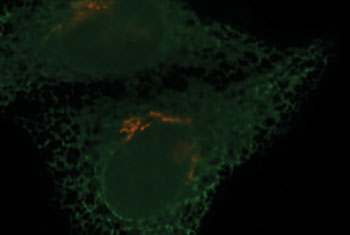Extracellular Protein Kinase Interacts with Broad Spectrum of Potential Substrates
By LabMedica International staff writers
Posted on 02 Jul 2015
A single enzyme, Fam20C (family with sequence similarity 20, member C), has been linked to the phosphorylation of more than 100 different proteins representing nearly 90% of all phosphorylated secreted proteins.Posted on 02 Jul 2015
Fam20C is a Golgi localized serine kinase that phosphorylates both casein and other highly acidic proteins and members of the small integrin-binding ligand, the N-linked glycoproteins family at the target motif serine-X-glucosamine.

Image: Cells stained orange to illuminate the endoplasmic reticulum and Golgi apparatus, the parts of the cell where the enzyme Fam20C might phosphorylate other proteins (Photo courtesy of University of California, San Diego).
Investigators at the University of California, San Diego (USA) utilized CRISPR/Cas9 gene editing as well as mass spectrometry and biochemical techniques to learn more about the role of Fam20C.
CRISPRs (clustered regularly interspaced short palindromic repeats) are segments of prokaryotic DNA containing short repetitions of base sequences. Each repetition is followed by short segments of "spacer DNA" from previous exposures to a bacterial virus or plasmid. CRISPRs are found in approximately 40% of sequenced bacteria genomes and 90% of sequenced archaea. CRISPRs are often associated with cas genes that code for proteins related to CRISPRs. The CRISPR/Cas complex comprises a prokaryotic immune system that confers resistance to foreign genetic elements such as plasmids and phages and provides a form of acquired immunity. Since 2013, the CRISPR/Cas system has been used in research for gene editing (adding, disrupting, or changing the sequence of specific genes) and gene regulation. By delivering the Cas9 protein and appropriate guide RNAs into a cell, the organism's genome can be cut at any desired location.
The investigators reported in the June 18, 2015, online edition of the journal Cell that use of the CRISPR/Cas system had allowed them to identify more than 100 secreted phosphoproteins as genuine Fam20C substrates. Further, they showed that Fam20C exhibited broader substrate specificity than previously thought. Appreciation of the functional rationale of Fam20C substrates suggested roles for the kinase beyond biomineralization, including lipid homeostasis, wound healing, and cell migration and adhesion.
“Nearly 60 years of protein phosphorylation research has uncovered many important functions for phosphorylation of proteins inside the cell, so there is no reason to believe these mechanisms will be any different for phosphorylation of proteins outside the cell,” said first author Dr. Sandra Wiley, a staff research associate at the University of California, San Diego. “We are now investigating the biological function and importance of each protein phosphorylated by Fam20C.”
Related Links:
University of California, San Diego









 Analyzer.jpg)




